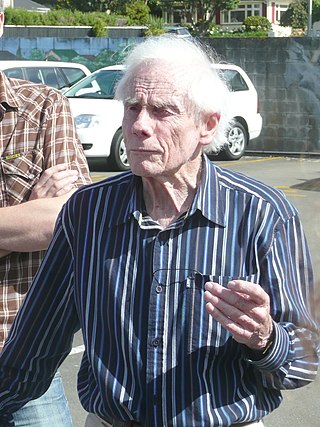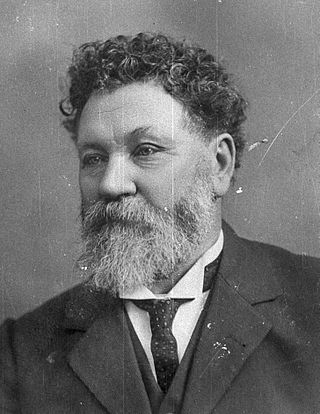Related Research Articles
Akaroa was a New Zealand electorate. It was located in Banks Peninsula, Canterbury, and named after the town of the same name. One of the original 24 electorates, it existed from 1853 to 1893.

Te Aro is an inner-city suburb of Wellington, New Zealand. It comprises the southern part of the central business district including the majority of the city's entertainment district and covers the mostly flat area of city between The Terrace and Cambridge Terrace at the base of Mount Victoria.

Te Ngākau Civic Square is a public square in central Wellington, New Zealand, between the Wellington central business district to the north and the Te Aro entertainment district to the south.
Shona Rapira Davies is a sculptor and painter of Ngātiwai ki Aotea tribal descent. Currently residing in Wellington New Zealand.
William Hildebrand Alington was a New Zealand modernist architect, whose work was awarded nationally, and recognised internationally. He was the husband of New Zealand historian Margaret Alington.

Stanley William Toomath was a New Zealand architect who practised mainly in Wellington. He was a founding member of the Architectural Group in Auckland in 1946, a life member of the Wellington Architectural Centre and a Fellow of the New Zealand Institute of Architects. Both the founding of the Group and the Architectural Centre were important factors in New Zealand's modernist architectural history.
James Albert Beard was a New Zealand architect, town planner, and landscape architect.

John McLachlan was a New Zealand Member of Parliament for Ashburton in the South Island.
Te Aro was a parliamentary electorate in Wellington, New Zealand from 1881 to 1890. It covered the southern area of the central business district. During the three parliamentary terms of its existence, the electorate was represented by three Members of Parliament.
Ellesmere was a parliamentary electorate in the Canterbury region of New Zealand. It existed for two periods between 1861 and 1928 and was represented by six Members of Parliament.
St Albans was a parliamentary electorate in Christchurch, New Zealand from 1881 to 1890, then from 1946 to 1996.
The 8th New Zealand Parliament was a term of the New Zealand Parliament.
Francis Gordon Wilson was an Australian born, New Zealand architect. Wilson oversaw the design of New Zealand’s state housing programme from the 1930s onwards. He was the New Zealand Government Architect at the time of his death.

Lisa Walker is a contemporary New Zealand jeweller.
Donald Clendon Peebles was a New Zealand artist. He is regarded as a pioneer of abstract art in New Zealand, and his works are held in the collections of Auckland Art Gallery Toi o Tāmaki, the Museum of New Zealand Te Papa Tongarewa, and Christchurch Art Gallery.
Megan Mary Wraight was a New Zealand landscape architect who had considerable influence on the design of public spaces. She was the founding principal of Wraight + Associates Limited, which has completed a wide variety of large-scale urban projects throughout New Zealand, including waterfront redevelopments, educational facilities, transport facilities and urban-renewal projects.

David George Porter was a New Zealand architect, company director and politician. He was a Wellington City Councillor and Deputy-Mayor from 1970 to 1971.
Julia Gatley is an architect, academic, architectural historian and author from New Zealand. As a historian and author Gatley has contributed knowledge about New Zealand's built landscape. She is the author of the book Athfield Architects about one of New Zealand's most well-known contemporary architects Ian Athfield and is a regular commentator about New Zealand's architectural history.
Sarah Treadwell is an artist, architect and academic in New Zealand. She was the first female full-time academic staff member in the School of Architecture and Planning at the Waipapa Taumata Rau the University of Auckland in New Zealand. Her academic career spanned from 1981 to 2017, her year of retirement. Treadwell was Head of School at the School of Architecture and Planning from 2009 to 2012.
Raukura Maria Turei is a New Zealand artist, actor and architect. She works with Māori iwi to design community-focused developments at the architectural practice Monk Mackenzie Architects. Her paintings have been exhibited throughout New Zealand, and she appeared in the New Zealand film The Dead Lands.
References
- Architectural Centre (N.Z.) Demonstration House (Wellington: Architectural Centre, 195-?)
- Architectural Centre (Wellington, N.Z.) Wgtn 196X: city development (Wellington: Architectural Centre, 1961)
- Architectural Centre Wellington’s northern gateway: an exhibition of the rail-yards, ports of Wellington and associated land by the Architectural Centre: November 1999. (Wellington: Architectural Centre, 1999)
- "Architectural Centre Aims at High Ideals" The Dominion (Wednesday 2 April 1947) p. 6.
- "Architectural Centre's "Ideal" House" Building Progress (March 1949) p. 34.
- Beard, James Albert, Social concern, building and the Architectural Centre, Wellington (Wellington: New Zealand Heritage and Conservation Trust and Wellington Heritage and Conservation Trust, 1997)
- Design review (Wellington: Architectural Centre, 1948)
- Gatley, Julia "A Contemporary Dwelling: The Demonstration House" Zeal and Crusade: the modern movement in Wellington ed John Wilson (Christchurch: Te Waihora Press, c1996) pp. 88–95.
- "Homes Without Sprawl – An Exhibition about Houses and gardens prepared by the Architectural Centre" Home & Building (1 August 1958) v. XXI, n. 3, pp. 33–37.
- Marriage, Guy "Doing each other's thing" Architecture New Zealand (Jan/Feb 2005) n. 1, pp. 78–79.
- Walker, Paul "Order from Chaos: Replanning Te Aro" Zeal and Crusade: the modern movement in Wellington ed John Wilson (Christchurch: Te Waihora Press, c1996) pp. 79–87.
- "What is 'the Architectural Centre'?" Design Review (Apr/May 1949) v. 1, n. 6, pp. 17–18.